|
||||||
|
PRUNUS. Blackthorn and Cherries. [Rosaceae] |
|
|
Eighteen species of Prunus are recorded in Britain. These include the native Blackthorn (P. spinosa), Bird Cherry (P. padus) and Wild Cherry (P. avium) and the introduced Cherry Plum (P. cerasifera). The BSBI provide a downloadable plant crib for Prunus. Forty-three miners are recorded on Prunus. A key to the European miners recorded on Prunus is provided in Bladmineerders van Europa. |
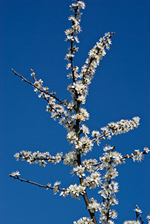 Blackthorn Prunus spinosa |
|
Key for the identification of the known mines of British |
1a > Leaf-miner and case-bearer: The larva lives outside the mine, protected by a case, and feeds on the underlying plant tissues via a hole cut in the epidermis. From that point it eats away as much leaf tissue as it can reach without fully entering the mine. Mine does not contain frass (Coleophora species) |
1b > Leaf-miner, but not a case-bearer: The larva lives mainly inside the mine. Mine usually contains frass. In later instars the larva may live sandwiched between two more or less circular sections cut from the leaf. |
2a > Leaf-miner and case-bearer: The first case is cut out of an oval mine in the centre of the leaf. The second and third, final, case are excised out of a mine along the leaf margin, and therefore have a serrate dorsal keel. The final case is a spatulate leaf case, 6-7 mm long, with a bivalved, square-cut rear end. The mouth angle is c. 45°. |
|
Coleophora adjectella Hering, 1937 [Lepidoptera: Coleophoridae]. |
2b > Leaf-miner and case-bearer: The early case is tiny and the larva makes a series of tiny holes on the leaf. After overwintering it makes a shiny pistol shaped case in spring and window feeds. The young larva, before hibernation, makes tiny mines, sometimes tens in one leaf. After hibernation window feeding is done. In this latter stage the larva lives in a shining black pistol case of about 7 mm, that, with a mouth angle of 70°-80°, stands almost perpendicular on the leaf. |
|
Coleophora anatipenella (Hübner, 1796) [Lepidoptera: Bucculatricidae]. |
2c > Leaf-miner and case-bearer: The larva initially makes a blotch mine in the leaf, which it then excises to form its case. The larva overwinters in its case before resuming feeding in spring. A new case, 6-7 mm long, is then constructed from a further blotch mine. The second case is indistinguishable from C. spinella and C.prunifoliae. The final case is a tubular leaf case, 6-7 mm long, light brown at first, darker later. The rear end is trivalved, the mouth opening is around 45°. The larvae live at the underside of the leaves, and make sizable full depth mines. |
|
Coleophora coracipennella (Hübner, 1796) [Lepidoptera: Coleophoridae]. |
2d > Leaf-miner and case-bearer: The full grown larva lives in a dull black pistol case of c 9 mm that, with a mouth angle of 80-90° stands erect on the leaf. Characteristic is the presence of some ear-like flaps. At least after the hibernation the larvae do not mine any more, but rather cause skeleton feeding. |
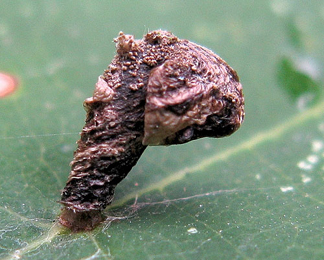 Case of Coleophora currucipennella on Quercus rubra Image: © Paul van Wielink (Bladmineerders van Europa) |
|
Coleophora currucipennella Zeller, 1839 [Lepidoptera: Coleophoridae]. |
2e > Leaf-miner and case-bearer: The species spends two years as a larva, the first one-and-a-half years in a small pistol-case, and in the second spring building a long straight case which is dark brown and rather distinctive. The lava lives from autumn until summer next year. In autumn a composite leaf case is made, shaped like the handle of a walking stick. Early in the following spring a tubular leaf case is made that in the end is rather large (10 mm) and is positioned vertically on the leaf; mouth angle 90°. |
|
Coleophora hemerobiella (Scopoli, 1763) [Lepidoptera: Coleophoridae]. |
2f > Leaf-miner and case-bearer: The case resembles that of C. violacea, but does not lie so flat again the leaf as this species (having a mouth angle of 30 to 50°). C. violacea also has a case which bulges in the middle, whereas in C. potentillae the case tapers towards the posterior. Immediately after emergence the larva makes a full depth, quickly widening, corridor, with frass as small grains in a broad central band. Finally results a blotch of 2 x 5 mm, from which the youth case is cut. The fully developed case is a hairy, greyish brown to silver grey lobe case of about 1 cm long, with a clearly laterally compressed end; the mouth angle is about 90°. The case is difficult to separate from that of C. ochripennella. |
|
Coleophora potentillae Elisha, 1885 [Lepidoptera: Coleophoridae]. |
2g > Leaf-miner and case-bearer: Tubular leaf case, 6-7 mm long, light, later dark brown, trivalved, with a mouth angle of 45°. The larva lives at the underside of the leaf, and makes sizable full depth mines there. |
|
| Coleophora prunifoliae Doets, 1944 [Lepidoptera: Coleophoridae]. |
2h > Leaf-miner and case-bearer: The larva feeds by inserting its head into small mines it creates on the leaves of birch, elm, alder, or hazel. Occasionally it is found feeding on other trees, or on herbaceous plants onto which it has accidentally Fallén. It forms two cases during its larval life. The first case is initially curved, smooth, laterally compressed with a bivalved anal opening, and about 2 mm long in September. During October it feeds, and adds a few rough collars of larval material around the oral opening. After hibernation, it feeds again in April and early May, adding more protruding collars until they equal or exceed the original smooth part of the case. At the same time, it expands the case girth by the creation of a silk gusset ventrally. The second case, 6 or 7 mm long, is formed in May, leaving the vacated first case attached to its last feeding mine. The new case is tubular with a trivalved crimp at the anal opening. The dorsum is formed from the edge of the leaf from which the case was cut. This results in a more or less serrated dorsal keel, depending on the plant species and the individual piece of leaf used. Considerable variation in the degree of serration can be found, even among specimens off the same tree. The case colour varies with food plant, from yellowish brown on birch, darkening through elm and hazel to dark brown on alder. The strongly curved young case is is a composite leaf case, the adult case is a tubular leaf case. The adult case is bivalved, about 7 mm in length; the mouth angle is around 30°. The case is straw coloured and almost always has a toothed dorsal keel (remnant of the margin of the leaf from which the case was cut). Neither larvae or cases of C. coracipennella, prunifoliae, serratella and spinella can be separated; from serratella. |
|
Coleophora serratella (Linnaeus, 1761) [Lepidoptera: Coleophoridae]. |
2i > Leaf-miner and case-bearer: Larva in autumn forming a few small mines. Feeding restarts in the same case in spring before changing to a new case by late April. In spring the cases or mines cannot be reliably separated from those of C. coracipennella or C. prunifoliae. The larva lives two years. In the first year, in autumn, a composite leaf case is made that resembles a boomerang: front and rear end stand at almost right angles. In its second year the larva makes a trivalved tubular leaf case of about 6 mm, with a mouth angle of c. 45°; the case tapers somewhat to both ends. |
|
Coleophora spinella (Schrank, 1802) [Lepidoptera: Coleophoridae]. |
2i > Leaf-miner and case-bearer: Tubular silken case of only 5-6 mm. The case is weakly constricted near the anal end, and strongly just behind the mouth. The case is sharply bent there; therefore the mouth angle is 0° and the case lies adpressed to the leaf. The fully developed case normally is trivalved. Larvae at the underside of the leaf. |
|
Coleophora trigeminella Fuchs, 1881 [Lepidoptera: Coleophoridae]. |
2j > Leaf-miner and case-bearer: The larva feeds on a wide range of trees, shrubs and herbs, favouring Rosaceae, but not exclusively. The fully developed cased larva may be found active in October and again, after winter diapause, in April. Cases, about 6 mm, of diapausing larvae may be found through winter, fixed to a tree or fence post. The dorsal surface of the case is usually covered in leaf fragments, but they can sometimes be worn off almost smooth. The ventral surface is swollen at the middle and has a keel, which usually bends upwards at the posterior. The cases of C. ahenella (on Rhamnus, Frangula, Viburnum and Cornus) and C. potentillae (case less swollen, keel not bent up, resting position less prone) are very similar. Brownish lobe case that lies almost flat on the leaf, either on the upper or on the lower side. Case widest about the middle. Ventrally there is a distinct keel. Mouth angle 0°. Full depth mines rather large. The flaps of cuticular tissue that serve to enlarge the case are cut out of the upper epidermis. (contrary to C. ahenella and C. potentillae, that use tissue from the lower epidermis). The removal of these tissue flaps creates holes that are much larger than those that serve as the entrance to the mine. |
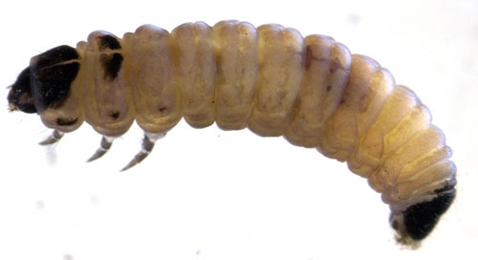 Coleophora violacea larva, lateral Image: © Willem Ellis (Bladmineerders van Europa) |
|
Coleophora violacea (Ström, 1783) [Lepidoptera: Coleophoridae]. |
| 3a > Leaf-miner: The larvae initially mining the leaves in a short, contorted gallery. As the larva develops it leaves the mine to feed externally, creating windows on the upperside of the leaves. Oviposition at the leaf upperside, egg shell iridescent. Small, hook-like corridor, mostly in a vein axil. Frass in a very thick central line. The larva soon leaves the mine through an untidy hole and subsequenty feeds living freely on the leaf. Pupation occurs in a ribbed white cocoon spun on debris. The winter is passed in this stage.. |
|
Bucculatrix bechsteinella (Bechstein & Scharfenberg, 1805) [Lepidoptera: Bucculatricidae]. |
3b > Leaf-miner: Upper-surface blotch. The inner wall is lined with much silk, giving the mine a white colour. The silk also causes the mine to contract, pulling the leaf margins upwards; the mine can be almost completely hidden from view in this way. All frass is ejected from the mine. Pupation within the mine. |
|
Coptotriche gaunacella (Duponchel, 1843) [Lepidoptera: Tischeriidae]. |
3c > Leaf-miner: The larvae form galleries along the edge of the leaf, leading to the development of large blotches on the leaf margin. Oviposition on the leaf underside. There begins a full depth corridor that gradually widens into an irregular elliptic blotch. Generally the corridor part for a large stretch follows the leaf margin. If oviposition occurred well away from the leaf margin, the corridor starts by making some irregular loops around the oviposition site; however, when, as often occurs, the egg is placed close to the leaf margin, at once the leaf margin is mined. Frass blackish brown (rarely brown) in the corridor, black in the blotch. In the corridor the frass lies in lumps or indistinct coils; in the blotch the frass is irregularly dispersed. Pupation outside the mine; exit slit in the upper epidermis, contrary to Bohemannia pulverosella, with which atricollis may co-occur on Apple. |
|
Ectoedemia atricollis (Stainton, 1857) [Lepidoptera: Nepticulidae]. |
3d > Leaf-miner: Makes an irregular blotch mine. The initial frass-filled gallery is very contorted (as shown. This distinguishes it from the mines of S.plagicolella, which have the initial gallery long and sinuous, with linear frass). It then makes an irregular gallery with clear margins and linear frass. Finally there is a small clear blotch, with the frass in a heap at the mouth of the gallery. The larva feeds with its ventral surface uppermost. Egg at the underside of the leaf, usually near the midrib, sometimes a side vein or the leaf margin. The first part of the mine is a narrow gallery, almost completely filled with reddish frass; the corridor is strongly contorted, almost forming a secondary blotch. The continuation is somewhat less contorted, and here the frass leaves clear margins. Finally the corridor widens into a rather small elongate blotch, where much of the copious frass is compacted in the basal section. The mine is compressed in a limited space, and the final blotch often obliterates earlier parts of the mine. |
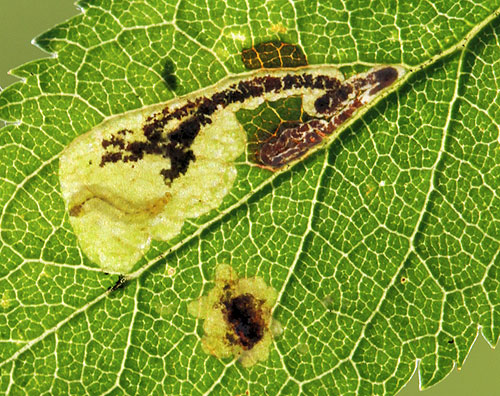 Mine of Ectoedemia spinosella on Prunus spinosa Image: © Willem Ellis (Bladmineerders van Europa) |
|
Ectoedemia spinosella (Joannis, 1908) [Lepidoptera: Nepticulidae]. |
3e > Leaf-miner: Oviposition by way of an ovipositor, no egg visible therefore. The larva makes an irregular blotch. The part of the mine nearest to the oviposition site is more thranslucent than the later, in transparancy more greenish, part of the mine. The mine usually lies close to the leaf tip, often several together. After its first moult the larva makes a roundish excision, 3-4 mm in diameter. Incurvaria larvae, while resting, take a horse-shoe like posture, unlike the larvae of Antispila species. Sandwiched herein it drops to the ground and continues feeding of dead leaves. The excision occupies about half of the surface of the blotch. The mine is also described in. |
|
Incurvaria oehlmanniella (Hübner, 1796) [Lepidoptera: Incurvariidae]. |
3f > Leaf-miner: The larva starts making a corridor of a few mm, followed, and mostly overrun, by a circular blotch of 4-5 mm diameter. Generally several larvae feed in a single leaf, creating a distinctive pattern of feeding windows. The larvae then cut out circular cases and drop to the leaf-litter to continue feeding, leaving behind a leaf containing many circular or oval cut-outs. |
|
Incurvaria pectinea Haworth 1828 [Lepidoptera: Incurvariidae]. |
3g > Leaf-miner: A circular or oval brownish blotch with a central spiral of dense blackish frass (British leafminers), sometimes several mines in one leaf. Oviposition is at the leaf underside, well away from the leaf margin; the egg has a fine reticulate surface. The mine is a rather large, perfectly circular blotch without a trace of a preceeding corridor. Around the dark centre the frass, glued to the upper epidermis is arranged in distinct arcs. Pupation in a silken cocoon, usually on detritus. |
|
Leucoptera malifoliella (O. Costa, 1836) [Lepidoptera: Lyonetiidae]. |
3h > Leaf-miner: A long, whitish smoothly-curved upper-surface mine with broken black frass. Oviposition is by means of an ovipositor; what remains is a small scar: no egg shell is visible at the start of the mine. From here a long, sometimes very long, slender, full depth corridor winds throught the leaf, not steered by leaf margin or the leaf venation. The midrib is crossed effortless; the corridor frequently also crosses itself; the section of the leaf cut off then usally turns brown and dies off. Frass in a narrow central line. The larva vacates the mine prior to pupation through an exit in the upper epidermis. The vacated larval chamber is proportionally much longer than in the case of Stigmella mines ( > 3 x longer than broad). Pupation in a silken cocoon suspended from threads attached to food plant or other vegetation. |
|
Lyonetia clerkella (Linnaeus, 1758) [Lepidoptera: Lyonetiidae]. |
3i > Leaf-miner: The larva mines the leaves of various roseaceous trees, such as blackthorn and apple, forming a gallery leading to a blotch. Eggs are deposited in the underside of a leaf, well away from the margin, often several per leaf. Around the oviposition site a cavity develops that in the end often leaves a hole in the leaf. Then a narrow, hardly widening, winding corridor, largely filled with a broad reddish brown frass line. The corridor abruptly widens into a wide, full depth blotch, that often lies against the leaf margin. The larva may leave its mine and continue elsewere, even on a different leaf. Note that the first blotch may already lie on a different leaf. Frass dispersed, in oval granules. Most frass is ejected through semicircular cuts along the outer limit of the blotch; part of it is often trapped in strands of silk under the leaf. The pupal cocoon is suspended from silken 'guy ropes' and closely resembles that of L. clerkella. |
|
Lyonetia prunifoliella (Hübner, 1796) [Lepidoptera: Lyonetiidae]. |
3j > Leaf-miner: The short full depth corridor mine is made in the leaf in September and the larva then hibernates on the axil of the leaf, making a web and feeding the next spring. In the spring they feed on the leaves from within a silk web. The larvae make a small full depth corridor in autumn. They pass the winter in a hiberaculum outside the mine, later they live free in a spinning. Pupation on a twig in a cocoon. |
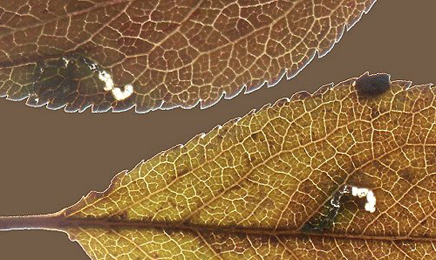 Mines of Paraswammerdamia albicapitella on Prunus spinosa Image: © David Manning (British leafminers) |
|
Paraswammerdamia albicapitella (Scharfenberg, 1805) [Lepidoptera: Yponomeutidae]. |
3k > Leaf-miner: Initially a lower epidermal gallery leading to a grey or whitish blotch which contorts the leaf strongly. Then at least two folds on the leaf margin, consuming the upper epidermis. The mine starts as a lower-surface epidermal corridor, that becomes widened into a blotch. The end result is a small, strongly inflated, tentiform mine between two side veins. The leaf tissue is eaten away up to the upper epidermis. The lower epidermis is opaque, mottled greyish, and strongly folded. Finally the mine is vacated and the larva continues under a leaf tip of margin that has been folded downwards; at least two of such folds are made and eaten out from the inside. Pupation in a cocoon in folded leaf-margin. |
|
Parornix finitimella (Zeller, 1850) [Lepidoptera: Gracillariidae]. |
3l > Leaf-miner: The initial mine is a blotch type. It then leaves this and makes folds on the leaf edge. The mine looks similar to Parornix finitimella and the larvae should be examined for identification of the mine. D. torquilella has legs concolorous with the body, whereas P. finitimella has black ringed legs (British leafminers, as Deltaornix torquillella). The mine begins as a lower-surface epidermal gallery that widens into a blotch. Finally it becomes a small, only weakly inflated tentiform mine, quadrangular of triangular when it lies in a vein axil. The lower epidermis is whitish, unfolded, and rather transparent. The leaf tissue is eaten up to the upper epidermis. Frass packed in a corner of the mine. The older larva leaves the mine, then lives free under a leaf tip or margin that has been folded downwards, or in a leaf that is rolled into a pod. Pupation in a cocoon under the folded edge of leaf (British leafminers, as Deltaornix torquillella). |
|
Parornix torquillella (Zeller, 1850) [Lepidoptera: Gracillariidae]. |
3m > Leaf-miner: A large mine, 15-20 mm long, more than six creases, in the lower epidermis. Relatively large, lower-surface tentiform mine; epidermis rather strongly folded. Pupa in the mine, in a white cocoon. |
|
Phyllonorycter cavella (Zeller, 1846) [Lepidoptera: Gracillariidae]. |
3n > Leaf-miner: The mine is underside, between veins, often causing leaf to arch. Several mines may be found in one leaf. Lower-surface tentiform mine, usually between two side veins, without clear folds. |
|
Phyllonorycter cerasicolella (Zeller, 1846) [Lepidoptera: Gracillariidae]. |
3m > Leaf-miner: The mine is an underside, strongly creased blister, causing a distinct pucker in the upperside of the leaf. Elongated, lower surface, tentiform mine with one strong fold in the lower epidermis. Pupa in a white cocoon, in which no frass in incorporated; all frass in a clump in the mine. Before ecdysis the pupa works itself out of the mine through the floor in the mine. Difficult to distinguish between P. cydoniella and P. blancardella on the basis of mine characteristics - both form arched tubes on the leaf of M. sylvestris. P. cydoniella tends to make the larger mine on M. sylvestris and the pupa is in a cocoon, with frass to one side. |
|
Phyllonorycter hostis Triberti, 2007 [Lepidoptera: Gracillariidae]. |
3o > Leaf-miner: The mine is in the upper epidermis of a leaf, usually over midrib or vein. The mine is at first silvery, later with brown speckling. Silvery, upper-surface, epidermal tentiform mine, centered over the midrib or a heavy lateral vein. Unlike P. leucographella, with which this species shares some host plants, the upper epidermis looks dirty by the presence of numerous fine black-brown specks of frass. The epidermis remains without folds until the mine becomes strongly contrated. Young mines look like a streak of silver on top of a vein. |
|
Phyllonorycter corylifoliella (Hübner, 1796) [Lepidoptera: Gracillariidae]. |
3p > Leaf-miner: Lower-surfce, yellow-green tentiform mine, 20-32 mm long, with a number of fine folds in the lower epidermis. In most cases the mine is elongate, situated between two lateral veins. The reddish to chestnut brown pupa lies in a flimsy cocoon in which no frass is incorporated: the frass is stored not in a clump but in a row of loose grains behind the cocoon. Just before edcysis the pupa works itself out of the mine through the lower wall; mostly the empty exuvium sticks halfway out of the mine. |
|
|
| Phyllonorycter mespilella (Hübner, 1805) [Lepidoptera: Gracillariidae]. |
3q > Leaf-miner: The mine is oval on Q. ilex (note - there may be several mines in the leaf), and similar to P. quercifoliella on deciduous oaks. It is between adjacent veins on beech and hornbeam. Small, oval, lower-surface tentiform mine, 9-14 mm long, mostly between two lateral veins. The lower epidermis with a single sharp fold (sometimes forked near its end). Pupa in very flimsy cocoon, that contains a bit of frass laterally and at the rear end. |
|
Phyllonorycter messaniella (Zeller, 1846) [Lepidoptera: Gracillariidae]. |
3r > Leaf-miner: A large mine with a strong crease in lower epidermis. Leaf-edge often folded downwards. Lower-surface, yellow-green tentiform mine with a few sharp folds in the epidermis. In Rowan the mine is parallel to the leaf margin, in Cherry usually between two lateral veins. The light brown cocoon lies in a wide cocoon, in which no frass is incorporated; all frass is accumulated in a clump in an angle of the mine. Before hatching the pupa penetrates the mine wall; generally the exuvium remains stuck halfway out of the mine. |
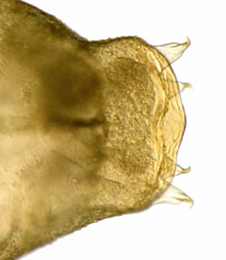 Phyllonorycter sorbi pupa, cremaster, dorsal Image: © Willem Ellis (Bladmineerders van Europa) |
|
Phyllonorycter sorbi (Frey, 1885) [Lepidoptera: Gracillariidae]. |
3s > Leaf-miner: A mine with several creases in lower epidermis, causing the leaf to arch or fold over. The larvae feed on blackthorn or sometimes wild plum. On blackthorn the mines are narrow and cause the leaf to pucker strongly, often folding right over, and being whitish, resemble those of the blackthorn-feeding Parornix species. Lower-surface, strongly inflated tentifom mine bewtwwn to side veins. Lower epidermis with folds, green. Pupa in a white cocoon, frass in a mass in a corner of the mine. Before emergence the pupa works itself halfway out of the mine. |
|
Phyllonorycter spinicolella (Zeller, 1846) [Lepidoptera: Gracillariidae]. |
3t > Leaf-miner: The small larvae leaf-mining at first, and later living externaly in a silken web. The young larva makes a full depth blotch. Most frass is ejected by a slit in the epidermis. Body dull yellowish, dorsal line yellowish green, a subdorsal line of dull red dots. Head pale yellowish (Agassiz, 1996a).. |
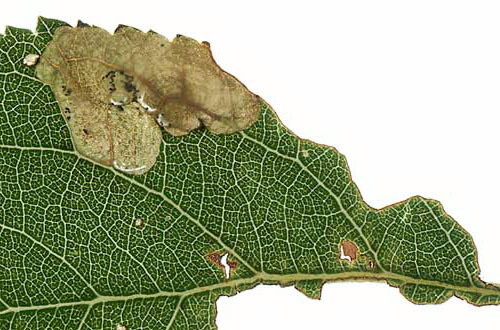 Mine of Pseudoswammerdamia combinella on Prunus spinosa Image: © Willem Ellis (Bladmineerders van Europa) |
|
Pseudoswammerdamia combinella (Hübner, 1786) [Lepidoptera: Yponomeutidae]. |
3u > Leaf-miner: The young larva mines the leaves of its foodplant then hibernates. It will then mines leaves or flowerbuds, then blossom or leaves. Branched, sometimes stellate, brownish, very transparent, sometimes long corridor that contains no frass. All frass is ejected through a number of tiny openings that generally are close to a vein. Only the young larvae are miners. |
|
Recurvaria nanella (Denis & Schiffermüller, 1775) [Lepidoptera: Gelechiidae]. |
3v > Leaf-mine: The young larvae make very small (≤ 3 mm) corridor or blotch mines, usually several in a leaf. The primary mine generally lies adjacent to the midrib; as far as I have seen the egg always is upper-surface. The secondary mines often are found in leaves without primary mine: obviously the larvae easily move to another leaf. The secondary mines are made from the underside of the leaf; while moving around silk is deposited under the leaf. Most frass is ejected from the mines, and part of the frass grains remain stuck in the spinning. Rather soon the larvae start living completely free in a common spinning under a leaf. They hibernate in a hibernaculum and continue living free in the spring. |
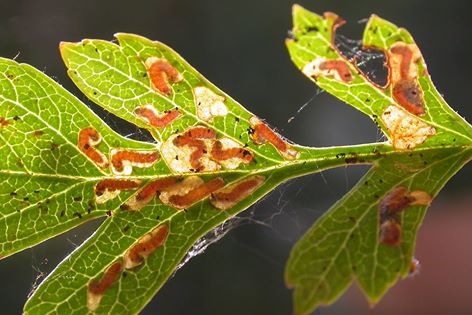 Mines of Scythropia crataegella on Crataegus Image: Ben Smart |
|
Scythropia crataegella (Linnaeus, 1767) [Lepidoptera: Yponomeutidae] |
3w > Leaf-miner: Usually a very small, pear-shaped, upper-surface blotch, most of it stuffed with reddish brown frass. Often several mines in a leaf. Ovipisition is already in May, but the larvae hatch late and initially develop very slowly; only against the end of summer the mines become apparent. The larvae remain in the mine and hibernate in the fallen leaves. The bright-coloured frass and their large number makes these mines very conspicuous in autumn, despite their small size. The weevils feed pinhole-sized windows in the leaf upperside (maturation feeding). |
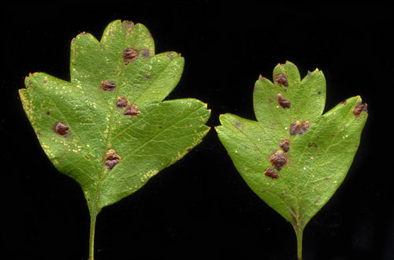 Minee of Rhamphus oxyacanthae on Crataegus monogyna Image: © Willem Ellis (Bladmineerders van Europa) |
|
Rhamphus oxycanthae (Marsham, 1802) [Coleoptera: Curculionidae]. |
3x > Leaf-miner: The gallery is sinuous, widening later, with linear frass. Egg at the underside of the leaf, near a vein. The mine is quite variable. It is a rather strongly tortuous corriodor, sometime widening only a little, sometimes strongly, at times ending in a secondary blotch. Frass black or brown, in a narrow central line. |
|
Stigmella malella (Stainton, 1854) [Lepidoptera: Nepticulidae]. |
3y > Leaf-miner: Egg at the underside of the leaf. The mine is a not very strongly contorted corridor, also not limited to a small portion of the leaf, and usually not forming a secondary blotch. Frass black. The frass line is very narrow, especially in the first section of the mine. In the second part the line may be broader, with the frass dispersed or indistinctly coiled, but always the width of the frass remains less than a third of the width of the corridor. |
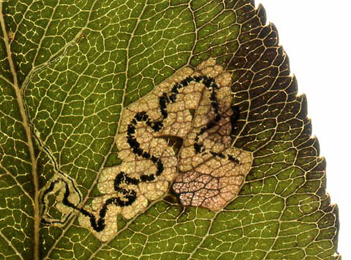 Mine of Stigmella minusculella on Pyrus communis Image: © Willem Ellis (Bladmineerders van Europa) |
|
Stigmella minusculella (Herrich-Schäffer, 1855) [Lepidoptera: Nepticulidae]. |
3z > Leaf-miner: The reddish frass is linear, later in arcs, finally dispersed. Long corridor, that widens only little, and winds freely through the leaf, not influenced by the venation. In thick, sun-exposed leaves the mine may be much shorter, especially in Cotoneaster, Malus and Pyrus. Frass brown, in arcs.. |
|
Stigmella oxyacanthella (Stainton, 1854) [Lepidoptera: Nepticulidae]. |
3za > Leaf-miner: A narrow gallery, leading abruptly to a blotch. Egg at the leaf underside. The first part of the mine consists of a slender undulating corridor with a proportionally wide uninterrupted frass line, that leaves a clear transparent zone at either side. After a moult this corridor widens aburptly into a bloth, that develops into the oppsite direction. The frass is concentrated here ia a diffuse central spot. The mine hardly ever crosses the midrib. Pupation outside the mine. |
|
Stigmella plagicolella (Stainton, 1854) [Lepidoptera: Nepticulidae]. |
3zb > Leaf-miner: A contorted gallery filled with green frass. Egg at the underside of the leaf, often close to a vein. The mine is a corridor, running in several half or whole circles around the oviposition site. Only the last segment breaks loose, and often runs along the leaf margin. The frass is greenish, lying in coils that are so wide as to almost completely fill the corridor. |
|
Stigmella prunetorum (Stainton, 1855) [Lepidoptera: Nepticulidae]. |
3zc > Leaf-miner: Full depth blotch, invariably beginning at the leaf tip or the tip of a leaf lobe or tooth. Oviposition site covered by a black, shining drop of hardened secretion. Frass generally in long threads, but sometimes in elongated granules. Pupation in the mine, not in a cocoon. |
|
Trachys minutus (Linnaeus, 1758) [Coleoptera: Buprestidae]. |
3zd > Leaf-mine: The eggs, laid on the spines (usually) or the stem, may hatch in about three weeks or overwinter. In Spring they mine the leaves or feed in buds. They then feed gregariously in a web, which extends as they consume the food source and, in severe infestations, the whole tree may be affected. |
|
Yponomeuta padella (Linnaeus, 1758) [Lepidoptera: Yponomeutidae]. |
3ze > Leaf miner. The egg is deposited in the base of the midrib. After oviposition the female severes the petiole, causing the petiole to break. The leaf start to wilt and falls, but still remains green for a considerable time. The larva tunnels in the midrib, and makes from there broad, full deep blotches in the lamina. Frass dispersed in the mine. Often several larvae in a leaf. Pupation in the ground. Blommers & Vaal (2002a) and Gønget (2003a) describe the biology in more detail.. |
On Crataegus, Mespilus and Prunus in Britain and Amelanchier, Cotoneaster, Crataegus, Cydonia, Malus, Prunus and Pyrus elsewhere. Recorded in several counties in southern Britain and widespread in continental Europe. |
Neocoenorrhinus pauxillus (Germar, 1824) [Coleoptera: Rhynchitidae] |
| Last updated 06-Jul-2019 Brian Pitkin | ||

